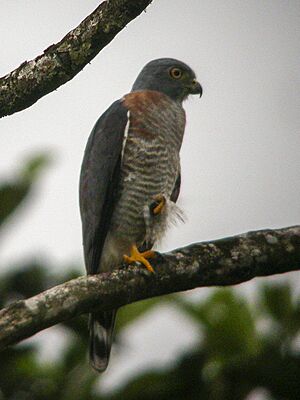Double-toothed kite facts for kids
Quick facts for kids Double-toothed kite |
|
|---|---|
 |
|
| Conservation status | |
| Scientific classification | |
| Genus: |
Harpagus
|
| Species: |
bidentatus
|
| Subspecies | |
|
|
 |
|
The double-toothed kite (Harpagus bidentatus) is a fascinating bird of prey. It's a type of hawk, even though its name includes "kite"! These birds live in forests from central Mexico all the way down through Central America and into many parts of northern and eastern South America. They are known for their sharp, "double-toothed" beak, which helps them catch their food.
Contents
About This Bird
Even though it's called a "kite," the double-toothed kite is actually a "true hawk." This means it's more closely related to other hawks than to most birds called kites. It belongs to a small group of birds with another similar bird called the rufous-thighed kite. There are two main types, or subspecies, of the double-toothed kite: H. b. bidentatus and H. b. fasciatus.
What Does It Look Like?
The double-toothed kite is a medium-sized bird. It grows to be about 29 to 35 centimeters (11 to 14 inches) long. Its wings can spread out about 60 to 72 centimeters (24 to 28 inches). Males usually weigh between 160 to 200 grams (5.6 to 7.1 ounces). Females are a bit heavier, weighing about 190 to 230 grams (6.7 to 8.1 ounces).
This bird gets its name from two small, tooth-like bumps on the edge of its upper beak. Both male and female birds look similar. They have a dark gray head and a white throat with a dark stripe down the middle. Their upper body is a lighter gray. Their tail is blackish with three grayish bands and a gray tip. Their eyes are red, and their legs and feet are yellow.
The two subspecies have slight differences in their colors. The H. b. bidentatus subspecies has a reddish-brown chest and belly. The H. b. fasciatus subspecies has paler reddish-brown parts and more stripes on its belly. Young birds of both types have deep brown upper parts. Their undersides are whitish with bold brown streaks.
Where Does It Live?
The double-toothed kite lives in different areas depending on its subspecies. The H. b. bidentatus subspecies is found in Trinidad and from eastern Colombia across to Venezuela and the Guianas. It also lives south and east into the Amazon regions of Ecuador, Peru, Bolivia, and Brazil. There's also a separate group in southeastern Brazil.
The H. b. fasciatus subspecies lives from Jalisco and southern Veracruz in Mexico. Its range continues through the Caribbean slopes of Guatemala, Belize, and Honduras. It's also found on both sides of Nicaragua, Costa Rica, and Panama. From there, it goes into western Colombia and western Ecuador. Very rarely, one has been seen as far north as Texas.
These birds mostly live deep inside mature subtropical and tropical forests. You might also find them at the edges of forests, in clearings, or in younger forests. They can live from sea level up to about 1,200 meters (3,900 feet) in Costa Rica and Colombia. In Ecuador, they can be found even higher, up to 2,100 meters (6,900 feet).
How Does It Behave?
Movement
The double-toothed kite usually stays in one place. It doesn't migrate or travel far. However, as mentioned, one bird did wander all the way to Texas!
What Does It Eat?
This kite mainly hunts from a high spot inside the forest. It dives down to catch its food. Most of the time, it grabs prey directly from plants. Sometimes, it catches things while flying, and rarely, from the ground.
Its diet includes many different things. It eats insects like butterflies, cicadas, grasshoppers, katydids, crickets, beetles, wasps, caterpillars, and cockroaches. It also eats small animals like anoles and geckos. Occasionally, it will eat iguanas, bats, small birds, rodents, and even snakes. While it eats many insects, the larger animals make up more of its food by weight. These clever birds often follow groups of monkeys. They catch insects and small animals that the monkeys scare out of hiding.
How Does It Raise Its Young?
The breeding season for the double-toothed kite changes depending on where they live. But it usually happens in the local spring and early summer. During courtship, the male and female birds fly in special ways above the treetops. The male also brings food to the female while they are courting and when she is sitting on the eggs.
The female builds a saucer-shaped nest using small twigs. She places it high up in a tree fork, sometimes as high as 33 meters (108 feet) off the ground. The male might help her a little. Nests are often built at the edge of the forest. Usually, the female lays two eggs. She does almost all of the egg incubation herself. The eggs hatch after 42 to 45 days. The young birds are ready to fly about 27 to 31 days after hatching. They become fully independent around two months after they learn to fly.
What Sounds Does It Make?
The double-toothed kite makes high-pitched calls. These calls sound like "'tsip-tsip-tsip-tsip-wheeeeeoooip'" or a long "'wheeeeoooo'" or "'cheeeeee-it'". They use these sounds to defend their nest or when they are fighting. Pairs of birds make contact calls that sound like a whistled "'see-weeeeep'" or "'chee-weet'". Young birds make a "chee-weet" call when they want food.
Is It Endangered?
The IUCN (International Union for Conservation of Nature) has listed the double-toothed kite as a species of "Least Concern." This means they are not currently in danger of disappearing. They have a very large habitat range. Scientists estimate there are at least half a million adult birds. No immediate threats have been found for them. They are "relatively common" in the right kind of forest. However, they might not survive in areas where too many trees are cut down.



